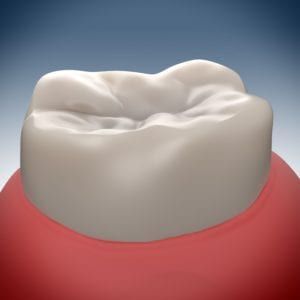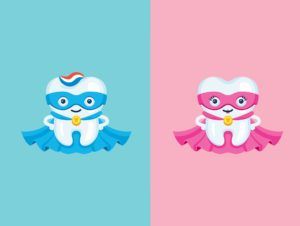Dental sealants are thin, plastic coatings that are brushed onto the surface of your child’s teeth to prevent tooth decay. Dental sealants form a protective layer over the chewing surfaces of teeth by bonding to the grooves in the enamel. They are most commonly applied to the back teeth because this is where chewing occurs and where most food particles get lodged into tight spaces. Since children can have a tough time getting into these tight spaces to properly remove food and plaque, they can accumulate and cause tooth decay. Dental sealants actively prevent tooth decay by sealing the tooth.
Did You Know?
A 2016 study completed by the Centers for Disease Control found almost three times more cavities in school-aged children without dental sealants and have concluded that dental sealants reduce the risk of school-aged children developing cavities by 80%.
Frequently Asked Questions:
Who needs dental sealants?
Dental sealants are primarily used for children aged 6-14 to protect their permanent teeth from developing cavities early on. In some cases, dental sealants may also be recommended for younger children in order to protect their baby teeth from being lost too soon. However, dental sealants can only be applied to the teeth once the chewing surface has completely eroded past the gum line.

What are dental sealants made of?
Dental sealants are made from an invisible plastic resin or glass ionomer coating. Glass ionomer is rarely used for dental sealants unless the tooth requires more moisture control, and the majority of dental sealants use plastic resin. Dental sealants made from plastic resin can contain a very tiny amount of BPA derivatives, which are different from pure BPA. However, the amount of BPA derivatives used in dental sealants is so minimal that it will not cause any harm to your child.
To establish a reference point, breathing air exposes your child to 100 times more BPA than the minuscule amount of BPA derivatives in dental sealants. It is also important to note that both the American Academy of Pediatric Dentistry and the American Dental Association stand behind dental sealants as being a safe dental treatment for children.
What do dental sealants look like?
There are different variations of dental sealants that appear clear, white, or slightly tinted to match a certain tooth color. Most dentists opt for the clear dental sealant because it does not alter the appearance of the teeth in any way and simply provides an invisible protective shield.

How are dental sealants applied?
First and foremost, dental sealants do not require numbing shots to apply because the application process does not generally cause any pain or discomfort. To apply a dental sealant, our dentists will first clean and dry the teeth to prepare them for sealing. Then, an acidic solution is applied to the teeth in order to roughen up the surface and allow for the secure bonding of the sealant. After the acidic solution is applied, the teeth will once again be rinsed and dried. Finally, the sealant will be brushed onto the chewing surface of the tooth. Usually the sealant will harden almost instantly and bond to the tooth’s surface, however sometimes a curing light may be used.
Can dental sealants be removed?
Dental sealants can be removed, however they are generally only removed if they are showing signs of excessive wear or if they have become damaged in some way. The removal of a dental sealant is usually followed by a replacement of that dental sealant.
Can dental sealants be placed over cavities?
Yes, dental sealants can be placed over cavities to prevent further damage from occurring. In fact, dental sealants are less expensive, less painful, and easier to apply than fillings. However, there may be cases when this is not always the case. Our dentists will help you to decide what the best option is for your child.

Do dental sealants hurt?
Dental sealants only need to be brushed onto the teeth and do not cause pain. The only discomfort that may be felt while getting dental sealants is your child having to hold their mouth open for a few minutes. Once the procedure is complete, your child may be vaguely aware that there is an extra layer on their teeth, but they will quickly get used to it and it should cause no issues.
Do dental sealants taste bad?
During the application process and immediately after, your child may notice a bad taste in their mouth. Experiencing a bad taste is a common occurrence with resin-based dental sealants and should fade with a few rinses. After about an hour following the placement of a dental sealant, the bad taste should fade and the dental sealant should become tasteless.
How long do dental sealants last?
Dental sealants can last up to ten years, however they will need to be regularly checked for signs of wear. If extensive wear is found, the dental sealant may need to be replaced. It is important to regularly have our dentists check your child’s dental sealants to make sure the sealant is working as intended. When dental sealants wear down, they can chip or break and bacteria can get caught underneath them, causing decay. Regular dental checkups allow our dentists to prevent this from occurring or from escalating.

How much do dental sealants cost?
Dental sealants are relatively inexpensive considering their benefits and generally cost about $30-$60 per tooth. In addition, because dental sealants are considered to be a preventative treatment, most dental insurance companies will offer full or partial coverage for patients under 18 years of age.
For the best pediatric dentist in Battery Park City, schedule a consultation at Battery Park Pediatrics. We are proud to provide a wide range of pediatric dental services to the communities of Brookfield Place, TriBeCa, Lower Manhattan, and Wall Street.

